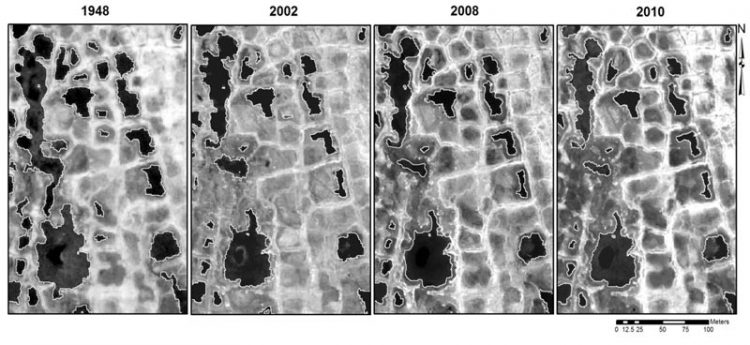Ponds are Disappearing in the Arctic

Image courtesy of Christian Andresen / UTEP Satellite images show how Arctic ponds have slowly decreased in size since 1948.
More than 2,800 Arctic tundra ponds in the northern region of Alaska’s Barrow Peninsula were analyzed using historical photos and satellite images taken between 1948 and 2010. Over the 62-year period, the researchers found that the number of ponds in the region had decreased by about 17 percent, while pond size had shrunk by an average of one-third.
“The 17 percent is a very conservative estimate because we didn’t consider ponds that had divided, or split into two ponds,” explained Christian Andresen, Ph.D., a postdoctoral fellow at UTEP who led the study. “Some ponds are elongated and as they shrink over time, they can be divided into two or more smaller ponds.”
The study, which has been accepted for publication in the Journal of Geophysical Research: Biogeosciences, was conducted by Andresen and Associate Professor of Biological Sciences Vanessa Lougheed, Ph.D.
The team points to warming temperatures and encroaching plants as one of the reasons the ponds are disappearing. As temperatures rise, nutrient-rich permafrost — a frozen layer of soil — thaws, releasing nutrients into ponds and enhancing plant growth.
“Plants are taking over shallow ponds because they’re becoming warm and nutrient-rich,” Andresen said. “Before you know it, boom, the pond is gone.”
Andresen worries that the geomorphology of the region’s landscape will change if these small bodies of water continue to shrink.
“The role of ponds in the arctic is extremely important,” he said. “History tells us that ponds tend to enlarge over hundreds of years and eventually become lakes; ponds shape much of this landscape in the long run, and with no ponds there will be no lakes for this region.”
Ponds in the Barrow Peninsula also serve as a major food source and nesting habitat for migratory birds, including certain waterfowl on the threatened species list, such as the spectacled eider (Somateria fischeri) and Steller’s eider (Polysticta stelleri). If the aquatic system continues to shift toward a drier community, their vital summer feeding and nesting grounds could disappear, affecting the future of these and many other migratory species.
Contact Information
Veronique Masterson
news@utep.edu
915-747-5526
Media Contact
More Information:
http://www.utep.eduAll latest news from the category: Earth Sciences
Earth Sciences (also referred to as Geosciences), which deals with basic issues surrounding our planet, plays a vital role in the area of energy and raw materials supply.
Earth Sciences comprises subjects such as geology, geography, geological informatics, paleontology, mineralogy, petrography, crystallography, geophysics, geodesy, glaciology, cartography, photogrammetry, meteorology and seismology, early-warning systems, earthquake research and polar research.
Newest articles

High-energy-density aqueous battery based on halogen multi-electron transfer
Traditional non-aqueous lithium-ion batteries have a high energy density, but their safety is compromised due to the flammable organic electrolytes they utilize. Aqueous batteries use water as the solvent for…

First-ever combined heart pump and pig kidney transplant
…gives new hope to patient with terminal illness. Surgeons at NYU Langone Health performed the first-ever combined mechanical heart pump and gene-edited pig kidney transplant surgery in a 54-year-old woman…

Biophysics: Testing how well biomarkers work
LMU researchers have developed a method to determine how reliably target proteins can be labeled using super-resolution fluorescence microscopy. Modern microscopy techniques make it possible to examine the inner workings…





















